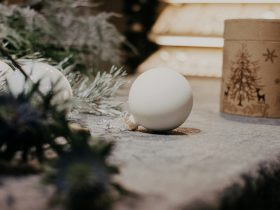Adding throw pillows to your home can effortlessly elevate its aesthetic.
To style throw pillows effectively, it’s essential to balance patterns, textures, and colours.
This guide will provide practical tips to mix and match throw pillows to enhance any room’s decor.
Choosing the right throw pillows involves considering the existing colour palette and design elements of your living space.
Opt for pillows that complement your furniture and wall colours while adding visual interest.
Variety in textures, such as combining velvet with linen or cotton, can create a layered and sophisticated look.
Don’t shy away from mixing patterns, but maintain cohesion by sticking to a consistent colour scheme.
Geometric patterns, florals, and solids can all work together if united by one or two common colours.
This approach ensures a stylish, harmonious look that adds personality and comfort to your space.
The Importance of Throw Pillows in Interior Design
Throw pillows are essential elements in interior design. They offer an easy way to add texture, colour, and pattern to any room.
By selecting pillows in various fabrics and hues, a space can be instantly updated and refreshed.
These small decor items can transform a neutral sofa or bed into a stylish focal point.
Mixing and matching different pillows creates layers of visual interest, giving the room a curated look.
This approach enables flexibility in styling without committing to larger furniture changes.
Throw pillows also contribute significantly to comfort. A sofa or chair can become much cosier with the addition of well-chosen pillows.
Beyond aesthetics, they offer support and can make seating areas more inviting.
Pillows can be functional too. Certain designs provide neck or lumbar support, adding practical benefits to their decorative role.
By choosing pillows that balance style and comfort, one can enhance both form and function in a room.
In terms of cost, throw pillows are a budget-friendly way to experiment with trends.
Unlike larger furniture pieces, pillows are relatively inexpensive and easy to replace or update.
This makes them an ideal choice for seasonal decor changes.
Choosing the Right Size and Shape for Your Throw Pillows
Selecting the correct size and shape of throw pillows can make a substantial difference to the visual appeal and comfort of your space. By paying attention to these factors, you can achieve a balanced and cohesive look.
Size Considerations
The size of throw pillows should match the dimensions of your furniture.
Standard sofas typically pair well with pillows measuring 18 to 24 inches.
For larger couches, consider pillows sized 24 to 26 inches to provide adequate coverage and comfort.
Smaller pillows, around 16 inches, work best on accent chairs, smaller sofas, or in layered arrangements with larger cushions.
Accurate measurement ensures a balanced and proportionate appearance.
Mixing various sizes can add depth and intrigue, so don’t be afraid to combine different dimensions.
Placement is also crucial; placing larger pillows at the back and smaller ones in front creates a structured and inviting look.
Shape Variations
Throw pillows come in several shapes, each adding a distinct aesthetic.
Square pillows are the most common and versatile, suitable for both traditional and modern styles.
Rectangular (lumbar) pillows provide excellent back support and create visual interest when mixed with square ones.
Round pillows introduce a playful element and soften the look of a space. They work particularly well in eclectic or bohemian decor.
Bolster pillows, with their cylindrical form, are great for adding an elegant touch and can be used at the ends of a sofa or bed for extra support.
Considering these shapes allows for creative combinations and helps tailor the decor to your specific style and functional needs.
Remember to balance different shapes to avoid a cluttered appearance.
Understanding Colour and Pattern Coordination
Choosing the right colours and patterns for throw pillows can transform any space by enhancing its visual appeal. Knowing the basics of colour theory and how to mix patterns is essential for creating a cohesive look.
Colour Theory Basics
Colour theory involves understanding how colours interact and complement each other. The colour wheel is a helpful tool for this, displaying primary, secondary, and tertiary colours.
Primary Colours: Red, blue, yellow
Secondary Colours: Orange, green, purple
Tertiary Colours: Mixes of primary and secondary colours.
To create harmony, consider analogous colours, which are next to each other on the colour wheel. For contrast, use complementary colours, which are opposite each other.
Analogous Combinations: Blue and green, red and orange
Complementary Combinations: Blue and orange, red and green
Monochromatic schemes, using different shades of a single colour, also work well for a subtle yet elegant look.
Mixing and Matching Patterns
Mixing patterns allows for a dynamic and interesting aesthetic.
Start with a primary pattern as the focal point and then add more subtle, secondary patterns to complement it.
Primary Pattern: This is the most dominant, such as a large floral or geometric design.
Secondary Patterns: These should be simpler, such as stripes, dots, or smaller motifs.
Ensure at least one colour is consistent across all patterns to maintain cohesion.
Balance is crucial; avoid overwhelming the space with too many bold designs.
For instance, pair a bold chevron pattern with a subtle polka dot. A large floral print can be balanced with a simple stripe or check pattern.
Selecting Materials and Textures
Choosing the right materials and textures for throw pillows can greatly influence the look and feel of a space. Key considerations include the type of fabric and how different textures interact to create visual interest and comfort.
Fabric Types
When selecting fabric for throw pillows, consider durability and ease of cleaning.
Common options include cotton, linen, velvet, and silk.
Cotton is popular for its softness and breathability, making it ideal for everyday use. Linen offers a more textured feel and a natural look, perfect for casual settings.
Velvet provides a luxurious touch and a rich appearance, suitable for formal spaces or adding a bit of glamour.
Silk, while elegant, can be less practical due to its delicate nature and higher maintenance requirements.
For outdoor pillows, select weather-resistant materials like acrylic or polyester, which can withstand various elements.
Textural Contrast
Combining different textures can add depth and interest to your decor.
For instance, pairing a smooth fabric like silk with a more textured material like linen creates a dynamic contrast.
This can be especially effective in monochrome schemes, where the play of textures substitutes for the lack of colour variation.
It’s also useful to mix materials based on their tactile qualities.
A knitted wool pillow next to a crisp cotton cushion provides a mix of tactile sensations.
When arranging throw pillows, aim for a balance that feels harmonious but not too uniform.
Use texture to highlight certain areas, drawing the eye to specific spots, which makes the whole setting more inviting.
Arrangement Techniques for Sofas and Beds
Styling throw pillows for sofas and beds involves strategic placement and varying techniques. Key methods include symmetry for balance, asymmetry for a creative look, and layering for depth and texture.
Symmetrical Arrangements
Symmetrical arrangements focus on balance and uniformity.
For sofas, place an equal number of pillows on each side. If using four pillows, have two on each end. Use pairs of matching pillows to create a mirror image.
For beds, place a pair of larger pillows at the back, then layer smaller matching pillows in front.
This method works well with a neutral or minimalist colour palette, creating a cohesive and polished appearance.
Asymmetrical Techniques
Asymmetrical techniques offer a more dynamic and eclectic look.
On a sofa, place different pillows on each side. For instance, a larger pillow on one end and two smaller ones on the other. Mix patterns, textures, and colours to create visual interest.
For beds, try combining various shapes and sizes. Place a large pillow on one side, followed by smaller pillows next to it.
This approach adds a unique and modern flair to your bedding.
Layering Methods
Layering methods enhance depth and texture.
On a sofa, start with larger pillows at the back. Gradually add smaller pillows in front.
Vary the textures, such as combining velvet and linen, for a rich feel.
For beds, begin with pillows stacked against the headboard.
Layer different shapes and sizes, starting with rectangular pillows at the back and layering smaller, decorative pillows at the front.
This technique adds complexity and a luxurious touch to your room.
Incorporating Throw Pillows in Various Decor Styles
Throw pillows are versatile decor elements that can enhance your living space. They add texture, colour, and personality to different interior styles, whether modern, traditional, bohemian, or minimalist.
Modern Contemporary
In a modern contemporary setting, throw pillows often feature clean lines and geometric patterns.
Neutral colours like grey, white, and black are predominant, but splashes of vibrant hues can add interest.
Materials such as leather, suede, and cotton are popular choices.
Opt for pillows with minimalist designs, avoiding overly intricate details.
A mix of large and small pillows arranged symmetrically can complement the sleek and uncluttered look of modern interiors.
Traditional Elegance
Traditional decor favours classic and timeless designs.
Throw pillows in luxurious fabrics like silk, velvet, and damask fit well. Rich colours such as burgundy, navy, and gold add an air of sophistication.
Decorative elements like tassels and embroidery enhance the traditional aesthetic.
Pillows with floral or paisley patterns can balance refined furniture, creating a harmonious and elegant space.
Grouping pillows in odd numbers (three or five) often works best.
Bohemian Chic
Bohemian style embraces diversity and creativity.
Throw pillows in vibrant and eclectic patterns are ideal. Think about global prints, bold colours, and a variety of textures like macramé, fringe, and embroidery.
Patterns such as tribal, ikat, and tie-dye work perfectly.
Mix and match different sizes and shapes to create a cosy, layered look.
Incorporate vintage or handmade pieces to add a unique touch and personality to the space.
Scandinavian Minimalism
Scandinavian minimalism focuses on simplicity and functionality.
Throw pillows in neutral tones like beige, grey, and soft pastels are commonly used.
Fabrics should be natural and comfortable—linen, cotton, and wool are suitable choices.
The patterns are typically understated, with stripes, checks, or subtle textures being popular.
Arrange pillows in a relaxed yet tidy manner, ensuring they enhance the serene and clutter-free vibe.
Care and Maintenance of Throw Pillows
Proper care and maintenance of throw pillows ensure they remain clean, comfortable, and long-lasting. Effective cleaning methods and smart storage solutions are essential.
Cleaning Tips
Regular cleaning keeps throw pillows fresh.
Machine-washable pillows should be washed every few months. Use a gentle cycle and mild detergent.
Non-machine-washable covers require spot cleaning with a damp cloth and mild soap.
For down or feather-filled pillows, use a large-capacity washer and avoid excessive detergent, as it can be difficult to rinse out.
Foam pillows should not be machine-washed; instead, spot clean with a mild detergent and let them air dry.
For stubborn stains, create a paste using baking soda and water. Apply it to the stain, let it sit for a few minutes, then wipe away with a damp cloth.
Storage Solutions
Proper storage helps maintain the shape and cleanliness of throw pillows.
When not in use, store them in vacuum-sealed bags to protect from dust and moisture.
For seasonal storage, use breathable fabric bags. These bags prevent the build-up of moisture and mildew.
Store pillows in a cool, dry place away from direct sunlight to avoid fading.
If you have limited storage space, consider using under-bed bins or closet organisers.
Label boxes or bags to easily identify different sets for quick access.
Seasonal and Thematic Styling for Throw Pillows
Styling throw pillows can be an easy way to refresh home décor, especially by aligning them with specific seasons or holidays.
Each approach adds a unique touch to a space, making it more pleasantly cohesive and timely.
Holiday Themes
Holiday-themed throw pillows bring festive cheer into living spaces.
For Christmas, opt for cushions in traditional colours like red, green, and gold with designs featuring snowflakes, trees, or reindeer.
Valentine’s Day can see the inclusion of heart motifs, using shades of pink and red.
Easter pillows might include pastel colours and illustrations of bunnies or eggs.
For Halloween, dark hues embellished with witches, pumpkins, and spooky themes are common.
Such thematic updates can be achieved with minimal changing yet create a significant festive impact.
Seasonal Updates
Seasonal changes in throw pillows can keep home interiors fresh throughout the year.
In spring, consider light fabrics and floral patterns in soft pastels.
Summer cushions can be vibrant, featuring bright colours like yellow, blue, and green, with tropical or nautical themes.
Autumn throw pillows might include warm tones such as oranges, browns, and deep reds, often with motifs of leaves or pumpkins.
Winter selections can have cosy, plush textures in hues of white, deep blue, or silver, reflecting the season’s stark and serene landscape.
Seasonal updates can rejuvenate home décor, aligning it fittingly with nature’s cycles.
Sourcing and Purchasing High-Quality Throw Pillows
High-quality throw pillows can be sourced from various retail outlets, purchased online, or custom made to suit specific tastes and needs.
Each option has its benefits and considerations to bear in mind.
Retail Outlets
Retail outlets offer the advantage of immediate availability. Shoppers can see and feel the pillows, ensuring they meet standards for comfort and quality.
Stores like John Lewis, Harrods, and Dunelm are known for their extensive collections.
Sales staff can provide personalised recommendations. Department stores often have seasonal sales that offer high-end pillows at discounted rates.
Assessing the craftsmanship and materials in person helps in making informed choices. Examine the stitching and fabric to ensure durability.
Online Shopping Tips
Online shopping provides a vast array of options that might be unavailable locally.
Websites like Wayfair, Etsy, and Amazon UK are popular choices for purchasing throw pillows.
Read customer reviews and ratings to gauge quality.
Pay attention to the product descriptions, focusing on materials and size specifications.
Many sites include high-resolution images and videos showcasing the product details.
Take advantage of online discounts, free shipping offers, and return policies that allow for a hassle-free shopping experience. This approach ensures satisfactory purchases.
Custom and Handmade Options
Opting for custom-made or handmade throw pillows allows for unique and personalised designs.
Artisans on platforms like Etsy and specialist stores offer bespoke services.
Discuss specific requirements, such as fabric type, colour, and design elements.
Handmade options often feature superior craftsmanship. They might come at a premium cost but typically provide excellent quality.
Supporting local crafters not only ensures originality but also contributes to sustaining artisanal skills and local economies.
Custom pillows can be made to match existing décor precisely.









Leave a Reply